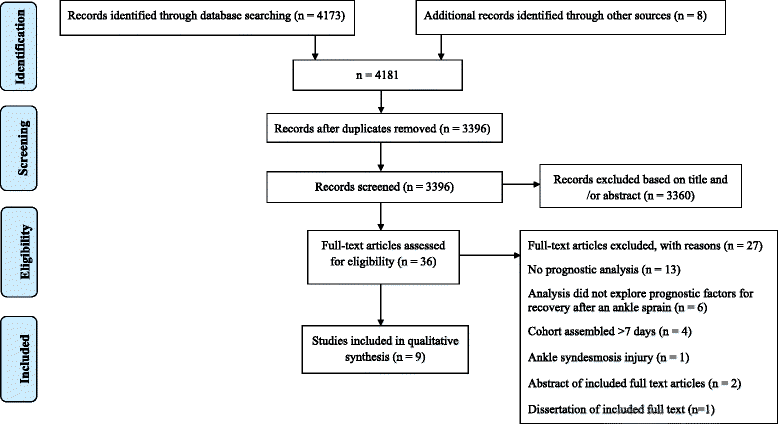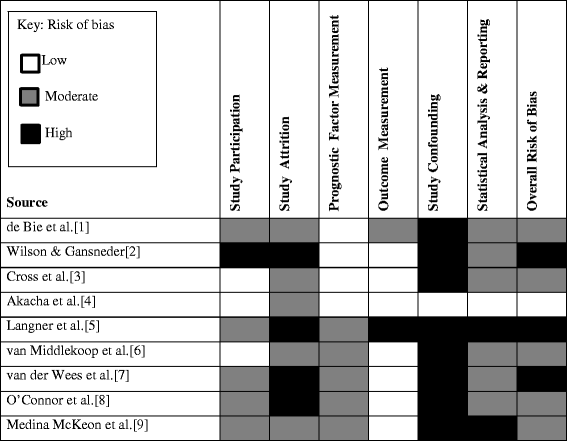Prognostic factors for recovery following acute lateral ankle ligament sprain: a systematic review
- PMID: 29061135
- PMCID: PMC5654104
- DOI: 10.1186/s12891-017-1777-9
Prognostic factors for recovery following acute lateral ankle ligament sprain: a systematic review
Abstract
Background: One-third of individuals who sustain an acute lateral ankle ligament sprain suffer significant disability due to pain, functional instability, mechanical instability or recurrent sprain after recovery plateaus at 1 to 5 years post injury. The identification of early prognostic factors associated with poor recovery may provide an opportunity for early-targeted intervention and improve outcome.
Methods: We performed a comprehensive search of AMED, EMBASE, Psych Info, CINAHL, SportDiscus, PubMed, CENTRAL, PEDro, OpenGrey, abstracts and conference proceedings from inception to September 2016. Prospective studies investigating the association between baseline prognostic factors and recovery over time were included. Two independent assessors performed the study selection, data extraction and quality assessment of the studies. A narrative synthesis is presented due to inability to meta-analyse results due to clinical and statistical heterogeneity.
Results: The search strategy yielded 3396 titles/abstracts after duplicates were removed. Thirty-six full text articles were then assessed, nine of which met the study inclusion criteria. Six were prospective cohorts, and three were secondary analyses of randomised controlled trials. Results are presented for nine studies that presented baseline prognostic factors for recovery after an acute ankle sprain. Age, female gender, swelling, restricted range of motion, limited weight bearing ability, pain (at the medial joint line and on weight-bearing dorsi-flexion at 4 weeks, and pain at rest at 3 months), higher injury severity rating, palpation/stress score, non-inversion mechanism injury, lower self-reported recovery, re-sprain within 3 months, MRI determined number of sprained ligaments, severity and bone bruise were found to be independent predictors of poor recovery. Age was one prognostic factor that demonstrated a consistent association with outcome in three studies, however cautious interpretation is advised.
Conclusions: The associations between prognostic factors and poor recovery after an acute lateral ankle sprain are largely inconclusive. At present, there is insufficient evidence to recommend any factor as an independent predictor of outcome. There is a need for well-conducted prospective cohort studies with adequate sample size and long-term follow-up to provide robust evidence on prognostic factors of recovery following an acute lateral ankle sprain.
Trial registration: Prospero registration: CRD42014014471.
Keywords: Acute lateral ankle sprain; Epidemiology; Prognostic factors; Recovery; Systematic review.
Conflict of interest statement
Authors’ information
CAST study.
Ethics approval and consent to participate
Not applicable. This is a systematic review of published studies.
Consent for publication
Not applicable
Competing interests
The authors declare that they have no competing interests.
Publisher’s Note
Springer Nature remains neutral with regard to jurisdictional claims in published maps and institutional affiliations.
Figures
References
-
- Waterman BR, Owens BD, Davey S, Zacchilli MA, Belmont PJ., Jr The epidemiology of ankle sprains in the United States. The journal of bone and joint surgery. Am Volume. 2010;92(Suppl 13):2279–2284. - PubMed
-
- Cooke MW, Marsh JL, Clark M, Nakash R, Jarvis RM, Hutton JL, Szczepura A, Wilson S, Lamb SE. Treatment of severe ankle sprain: a pragmatic randomised controlled trial comparing the clinical effectiveness and cost-effectiveness of three types of mechanical ankle support with tubular bandage. The CAST trial. Health Technol Assess. 2009;13(Suppl 13):iii. ix-x, 1-121. - PubMed
Publication types
MeSH terms
Grants and funding
LinkOut - more resources
Full Text Sources
Other Literature Sources
Medical
Miscellaneous



